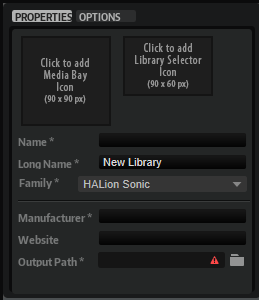Properties
In this section, you can name the library and add icons and further information. Text fields with an asterisk (*) are mandatory.

- MediaRack Icon
-
Click this field to select an icon to be shown in the MediaBay of the Steinberg DAW. The image must be a .png file 90 x 90 pixels in size.
- Library Selector Icon
-
Click this field to select an icon to be shown in the library selector. The image must be a .png file 90 x 60 pixels in size. The preview of the library name below the icon allows you to check whether it needs to be shortened to be fully displayed in the library selector.
MediaRack and library selector icons support High DPI Mode. High DPI Mode requires additional bitmap resources. These bitmaps must be saved in the same folder as the standard resolution bitmap. The following naming scheme applies: for double-resolution files, add “_2.00x” to the end of the file name, for triple-resolution files, add “_3.00x”, etc.
- Name
-
Allows you to specify the name of the library. If you change the name after having created VST Sound containers, you are asked whether to rename the library or to create a new one. If you create a new library, all VST Sound containers are assigned new unique identifiers.
ImportantIt is important not to reuse VST Sound containers with the same identifiers for different libraries.
- Long Name
-
Allows you to specify a longer version of your library name. This is used in the MediaBay of the Steinberg DAW if it is not too long. Otherwise, the standard name is shown.
- Family
-
Allows you to specify the plug-ins that you want your library to be compatible with.
-
HALion: These presets cannot be loaded in HALion Sonic.
-
HALion Sonic: These presets can be loaded in HALion Sonic and HALion.
-
In most cases, compatibility with HALion Sonic is desirable, as it ensures access to all users. HALion Sonic is available as a free download on the Steinberg web site.
- Manufacturer
-
Allows you to add your name or the name of your company.
- Website
-
Allows you to add a URL to your web site.
- Output Path
-
Allows you to specify the folder on your system into which the VST Sound files are written. Each container is saved in a separate subfolder.